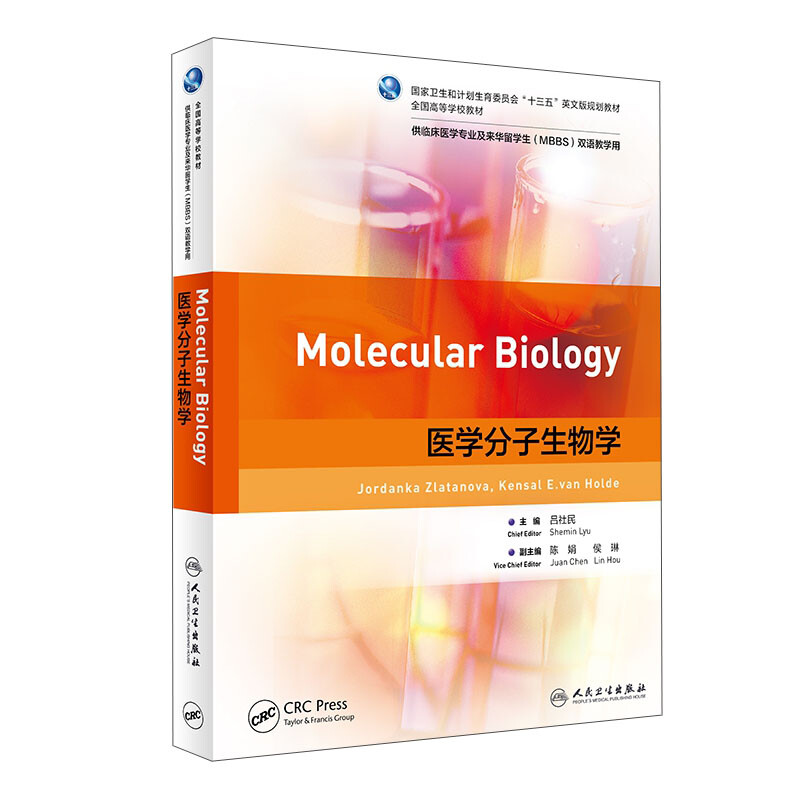
包邮医学分子生物学(本科/双语教材)

- ISBN:9787117328104
- 装帧:一般胶版纸
- 册数:暂无
- 重量:暂无
- 开本:其他
- 页数:456
- 出版时间:2022-03-01
- 条形码:9787117328104 ; 978-7-117-32810-4
本书特色
本书是根据Garland Science出版的Molecular Biology改编。作者对每一章节的内容进行了修改,特别增加了第15章疾病基因、第16章基因诊断和治疗,以满足中国医学生的需要。 分子生物学是在分子水平上研究生命现象、原理和本质的学科。分子生物学的定义是研究基因,一段DNA表达的功能产物,如RNA和蛋白质。此外,分子生物学的知识和技术已经融入到医学的各个学科中,促进和发展了一个新的医学分支,称为分子医学。分子医学是指了解疾病的病因、发病机制、发展和预后,运用分子生物学对疾病进行诊断、治疗和预防。因此,医学生必须熟悉分子生物学不仅仅是为了阅读论文,做实验也是为了使用正确的分子诊断和治疗方法。在中国医学教育体系下,编写适合中外学生培养的分子生物学课程和教材是基础和必要的。
内容简介
根据教育部相关文件规定,为满足医学院校临床医学专业双语教学和来华留学生教学的需要,在调研、论证的基础上组织编写本套教材。本教材为英文版规划教材之一,在引进外版教材的基础上,根据我国教学实际情况进行改编,以使知识体系和主要内容基本符合教学大纲的要求。主要内容:分子生物学是在分子水平上研究生命现象、原理和本质的学科。分子生物学的定义是研究基因,一段DNA表达的功能产物,如RNA和蛋白质。此外,分子生物学的知识和技术已经融入到医学的各个学科中,促进和发展了一个新的医学分支,称为分子医学。分子医学是指了解疾病的病因、发病机制、发展和预后,运用分子生物学对疾病进行诊断、治疗和预防。因此,医学生必须熟悉分子生物学不仅仅是为了阅读论文,做实验也是为了使用正确的分子诊断和治疗方法。在中国医学教育体系下,编写适合中外学生培养的分子生物学课程和教材是基础和必要的。主要特色:经过综合考虑,我们选择了Jordanka Zlatanova博士和Kensal E。van Holde由Garland Science出版的Molecular Biology作为我们的改编原书。我们对每一章节的内容进行了修改,包括删除和添加一些内容。我们特别增加了两个新的章节:第15章疾病基因,第16章基因诊断和治疗,以满足中国医学生的需要。因此,修订后的教材共有16章,每章都包含了主要内容:关键概念、关键词(中英文)、问题、参考文献。
目录
1.1 Introduction
1.2 Classical genetics and the rules of trait inheritance
1.2.1 Gregor Mendel developed the formal rules of genetics
1.2.2 Mendel's laws have extensions and exceptions
1.2.3 Genes are arranged linearly on chromosomes and can be mapped
1.2.4 The nature of genes and how they determine phenotypes was long a mystery
1.3 The great breakthrough to molecular genetics
1.3.1 Bacteria and bacteriophage exhibit genetic behavior and serve as model systems
1.3.2 Transformation and transduction allow transfer of genetic information
1.3.3 The Watson-Crick model of DNA structure provided the final key to molecular genetics
Chapter 2 Structures and Functions of Proteins and Nucleic Acids
2.1 Introduction
2.2 Proteins
2.2.1 Amino acids and peptides
2.2.2 Levels of structure in the polypeptide chain
2.2.3 Protein folding
2.2.4 Protein destruction
2.3 Nucleic acids
2.3.1 Chemical structure of nucleotides
2.3.2 Physical structure of DNA
2.3.3 Physical structures of RNA
2.3.4 One-way flow of genetic information
2.3.5 Methods used to study nucleic acids
Chapter 3 Recombinant DNA: Principles and Applications
3.1 Introduction of homologous recombination and cloning
3.1.1 The beginnings of recombinant DNA technology
3.1.2 Homologous recombination and cloning
3.2 Construction of recombinant DNA molecules
3.2.1 Major classes of restriction endonucleases
3.2.2 Recognition sequences for type II restriction endonucleases
3.2.3 DNA ligase joins linear pieces of DNA
3.2.4 Sources of DNA for cloning
3.3 Vectors for cloning
3.3.1 Genes coding for selectable markers are inserted into vectors during their construction
3.3.2 Plasmid DNA were the first cloning vector
3.3.3 Recombinant bacteriophages can serve as vectors
3.3.4 Cosmids and phagemids expand the repertoire of cloning vector
3.4 Expression of recombinant genes
3.4.1 Expression vectors allow regulated and efficient expression of cloned genes
3.4.2 Expression systems
3.5 Introducing recombinant DNA into host cells
3.5.1 Numerous host-specific techniques are used to introduce recombinant DNA molecules into living cells
3.5.2 Transient and stable transfection assays
3.6 Constructing DNA libraries
3.6.1 Type of different libraries
3.6.2 Library screening and probes
3.7 Sequencing of entire genomes
3.7.1 Genomic libraries contain the entire genome of an organism as a collection of recombinant DNA molecules
3.7.2 There are two approaches for sequencing large genomes
3.8 Practical application of recombinant DNA technologies
3.8.1 Gene therapy
3.8.2 Delivering a gene into sufficient cells within a specific tissue and ensuring its subsequent long-term expression is a challenge
Chapter 4 Tools for Analyzing Gene Expression
4.1 Introduction
4.2 Gene isolation and detection
4.2.1 Agarose gel electrophoresis of DNA
4.2.2 Gradient centrifugation
4.2.3 Nucleic acid hybridization
4.2.4 Polymerase chain reaction
4.2.5 In vitro mutagenesis
4.2.6 DNA sequencing
4.3 Analysis at the level of gene transcription: RNA expression and localization
4.3.1 Reverse transcription PCR
4.3.2 Northern blotting
4.3.3 RNase protection assay (RPA)
4.3.4 In situ hybridization
4.3.5 DNA microarrays
4.4 Analysis of the transcription rates
4.4.1 S1 nuclease protection and primer extension
4.4.2 Rapid amplification of cDNA ends ,
4.4.3 Reporter genes
4.4.4 DNA footprinting
4.4.5 Electrophoretic mobility shift assay
4.4.6 Chromatin immunoprecipitation
4.5 Analysis at the level of translation: protein expression and localization
4.5.1 Western blotting
4.5.2 Enzyme-linke
作者简介
吕社民,1988年在西安医科大学获生物化学与分子生物学专业医学硕士学位, 2002年2月在瑞典Lund大学获分子免疫学与遗传学博士学位。1982年12月至1995年9月在西安医科大学地方性骨病研究所,历任研究实习员、助理研究员、副研究员,研究所副所长兼生化研究室主任。2004年6月被西安交通大学聘任为生物化学与分子生物学教授,任职于西安交大医学院遗传学与分子生物学系; 2005年1月任系主任。2015年任基础医学院院长。
-

临床常用百药精解-国医精粹口袋书系
¥13.2¥32.0 -

杏林传习十三经:伤寒论 注解伤寒论
¥20.1¥59.8 -

黄帝内经
¥29.9¥76.0 -

联袂药性赋白话解-国医精粹口袋书系
¥9.3¥18.0 -

脉因证治
¥6.3¥13.0 -

彩色图解黄帝内经
¥17.9¥49.8 -

彩绘版国学经典名著:黄帝内经(精装)
¥25.3¥76.0 -

中医入门必背歌诀
¥16.4¥38.0 -

伤寒论
¥12.7¥13.0 -

国医大师张磊中医基础理论讲稿
¥14.7¥39.8 -

杏林传习十三经:灵枢经
¥14.7¥39.8 -

杏林传习十三经:脉经
¥14.7¥39.8 -

本草纲目
¥25.3¥76.0 -

外科急救常识图解
¥4.7¥4.0 -

常见急救常识图解
¥4.7¥4.0 -

内外伤辨惑论-局方发挥
¥4.9¥5.0 -

中医基础理论
¥12.3¥19.0 -

中药饮片的现代研究与应用
¥27.7¥39.6 -

金匮要略
¥9.7¥9.0 -

中医专家大讲堂
¥17.1¥39.8









